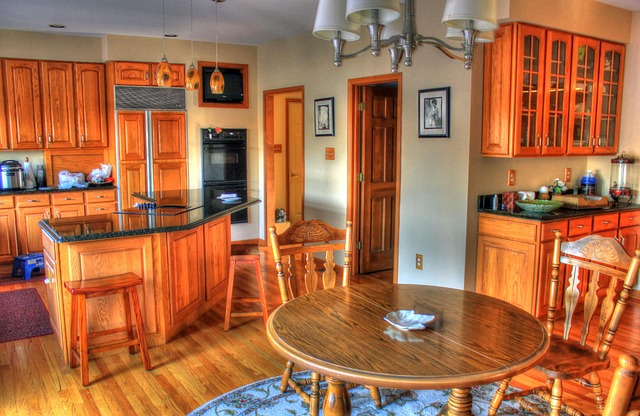In kitchen design, durable tiles are essential for their aesthetic appeal and practical benefits. Opt for moisture-resistant ceramic or porcelain tiles with anti-slip surfaces for safety and ease of cleaning. Explore diverse tile patterns from geometric to organic designs to enhance the space's ambiance while maintaining low maintenance. Proper installation techniques ensure a beautiful, functional kitchen with properly spaced tiles and watertight grout seals.
Looking to transform your bustling kitchen with enduring style? Discover the ultimate guide to high-quality, durable tiles that meet the rigors of daily use. We explore the critical factors like understanding kitchen tile demands, selecting materials for longevity, and mastering tile patterns for visual appeal. Learn expert installation tips for a seamless finish, ensuring your kitchen tiles not only endure but enhance your space. Dive into these insights to find the perfect tile patterns for your kitchen.
- Understanding the Demands of Kitchen Tiles
- Choosing Durable Materials for Longevity
- Exploring Tile Patterns for Visual Appeal
- Installation Tips for a Seamless Finish
Understanding the Demands of Kitchen Tiles
In the bustling environment of a kitchen, tiles play a pivotal role in both aesthetics and functionality. Understanding the demands of kitchen tiles is essential when selecting materials that can withstand high traffic, frequent cleaning, and exposure to moisture and heat. Unlike other rooms in the house, kitchens require tiles that are not just visually appealing but also highly durable and easy to maintain.
Tile patterns for kitchens should be chosen with these factors in mind. Anti-slip surfaces, water-resistant properties, and porous materials that prevent staining are some key attributes to look for. Additionally, a diverse range of designs, from subtle to bold, ensures that kitchen tiles can complement various décor themes while enhancing the overall ambiance and practicality of this essential space.
Choosing Durable Materials for Longevity
When designing or renovating a kitchen, selecting durable tiles is paramount for creating a long-lasting and low-maintenance space. In the heart of any home, kitchens endure frequent foot traffic, splashes of water, and exposure to heat from appliances—all factors that can contribute to tile wear and tear over time. To ensure your kitchen tiles stand the test of daily use, opt for materials known for their resilience. Ceramic and porcelain tiles, with their robust compositions, are popular choices due to their ability to withstand moisture and scratches. Additionally, these tiles offer a wide array of tile patterns for kitchens, allowing you to create an aesthetic that complements your style while ensuring practicality.
Moreover, considering the grout between tiles is essential. Grout lines can accumulate dirt and bacteria if not maintained properly, so choose grout materials that are easy to clean and resistant to stains. Non-porous grout options are ideal as they prevent moisture absorption, reducing the risk of mould or mildew growth in your kitchen. By selecting high-quality materials and considering long-term durability, you’ll create a kitchen environment that is not only visually appealing but also built to last.
Exploring Tile Patterns for Visual Appeal
When it comes to tile patterns for kitchens, the options are endless and can dramatically impact the space’s overall aesthetic. Beyond functionality, tiles offer a chance to create a visually stunning and unique environment that reflects your style. Exploring different tile patterns allows you to go beyond conventional layouts and embrace creative designs. For busy kitchens, where there’s often a lot of foot traffic and activity, choosing the right pattern is key to creating a space that feels both inviting and low-maintenance.
Opting for intricate tile patterns can add depth and texture, making the kitchen feel more dynamic and engaging. Geometric shapes, such as hexagons or diamonds, are popular choices due to their versatility and ability to create visually appealing arrangements. On the other hand, natural stone tiles with organic patterns can introduce warmth and character into the space. Whether you prefer a mosaic-style layout or a more uniform design, incorporating tile patterns can transform your kitchen into a striking and functional heart of your home.
Installation Tips for a Seamless Finish
When installing tiles in your kitchen, a seamless finish is key to creating an attractive and functional space. Start by preparing the surface, ensuring it’s clean and level. This step is crucial for achieving a smooth base for your tiles. Use appropriate adhesive and follow the manufacturer’s instructions for application, making sure to apply it evenly across the back of each tile.
For a kitchen with high foot traffic, consider using a mesh backing on your tiles to provide extra strength and stability. When laying the tiles, create a pattern that complements the room’s aesthetic, whether it’s a geometric design or a more organic layout. Gaps between tiles should be consistent, typically around 1-2 mm, to ensure proper drainage and prevent water damage. After setting each tile, use a rubber grout float to apply grout evenly, pressing gently into the spaces to create a watertight seal.
When it comes to high-performance kitchen tiles, understanding your space’s unique demands and choosing durable materials are key. By selecting the right tiles and exploring diverse patterns, you can create a visually appealing and functional kitchen that stands the test of time. With proper installation techniques, these tiles will not only enhance your kitchen’s aesthetics but also provide a seamless, long-lasting finish. Incorporate tile patterns for kitchens to add depth and character, ensuring your space remains both stylish and practical in the bustling heart of your home.
